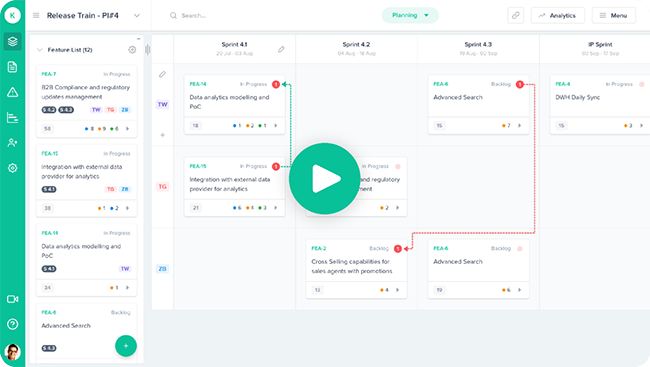Kendis is a digital solution for PI, Tribe and Big room Planning that works on top of Jira and Azure Boards.

“Those who cannot change their minds cannot change anything.” - George Bernard Shaw
The Scaled Agile Framework (SAFe) is an effective scaling framework that helps in aligning organizational goals. For larger organisations, it is one of the most popular Agile frameworks. A key and emerging role in this framework is that of the Release Train Engineer (RTE).
Termed as the servant leader of the Agile Release Train, the Release Train Engineer serves to fulfill the objectives of the Program Increment. Since this is a rather new concept, there are challenges and a mindset shift for managers that has to be embraced to become a successful RTE.
The Release Train Engineer is not different from a traditional Scrum Master. In fact, we can call it a Chief Scrum Master who conducts the Scrum of Scrums in SAFe. Each agile team of the Agile Release Train will have their respective Scrum Master. These scrum masters participate in the Scrum of Scrums which is lead by the Release Train Engineer. During retrospective sessions, the Release Train Engineer reports to the Product Owner. Usually, the RTE reports to the Agile Program Management office which in SAFe, is considered a part of the Lean Portfolio Management (LPM).
These responsibilities are no different than a traditional manager. So how is the Release Train Engineer different? And what are the challenges faced to become a release train engineer in SAFe?
“Change the way you look at things and the things you look at change.” - Wayne W. Dyer
Undoubtedly, the backbone for the success of SAFe is trust. Trust is instilled in the heart of SAFe. Trust creates strong relationships amongst teams, their leaders and the stakeholders. It promotes transparency and openness amongst the people.
For some managers, trusting can be difficult and may appear as a challenge to them.
It also requires a transition to adapt to the servant-leadership philosophy. A concept formulated by Robert Greenleaf in 1970, the following lists the step up from traditional managers to becoming servant leaders:
From deadlines to objectives
The vision has to be clearly defined in order to successfully accomplish the PI objectives. It is mandatory to clearly set the objectives of the PI. An iteration lasts for two weeks and if there are objectives that were not completed, they become part of the next iteration. So the only deadline is set for the Program Increment. Not for the iterations.
From driving “specific outcomes” to invest in “the program’s overall performance”
The collaboration and synergy of multiple Agile Teams in the Agile Release Train is vital towards achieving the objectives in the Program Increment.
From “knowing the answer” to “asking the teams” for the answer
Respecting and listening to the individual’s opinion is important rather than imposing what the manager thinks is right.
From “directing” to letting the “teams self-organize” and hit their stride.
Believing and trusting the teams work and guiding them.
From “fixing problems” to “helping teams to fix” themselves
The teams are empowered by having the freedom and the authority to make decisions at an individual level.
A Lean-Agile Mindset is necessary. This includes the knowledge of the House of Lean and the Agile Manifesto.
“Dripping water hollows out stone, not through force but through persistence.” - Ovid
Conclusion
Traditional managers need to be trained to become Servant Leader. Becoming a servant leader is not the sole aspect of becoming an RTE.
Instead of being the judge, the release train engineer has to be an excellent guide, motivator, coach and mentor to the teams. They need to be an exceptional leader. They need to exude confidence and their commitment to the vision in fulfilling the objectives of the Program Increment.
They have to inspire their teams to rigorously improve. They have to convey their passion and diligence to the teams in attaining the goals of the Program Increment. They have to be empathetic and supportive to serve their teams, not the organizational leaders or managers.
Unleash Your Organization’s True Potential to Scale Agile with Kendis
Kendis offers an all-inclusive solution to planning, tracking and managing your Program Increment and dependencies between distributed teams. It works on top of JIRA and other agile tools, your teams can keep on working with their existing JIRA boards and program level and above is planned and managed at Kendis.
Try out 10 days free trial or book a demo with our product expert.









